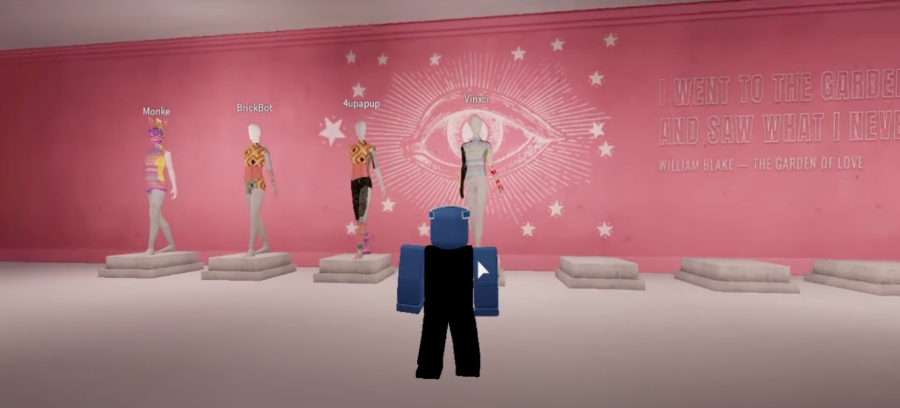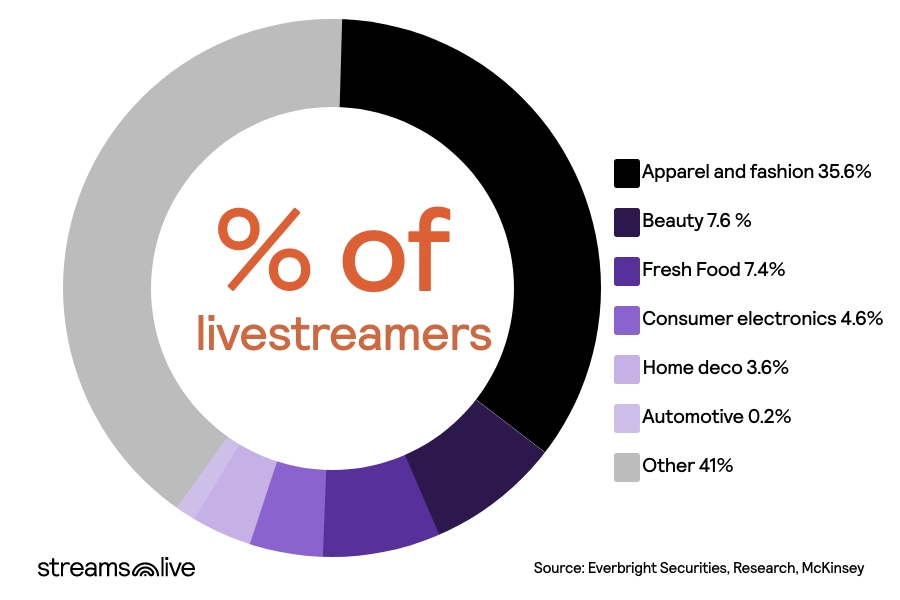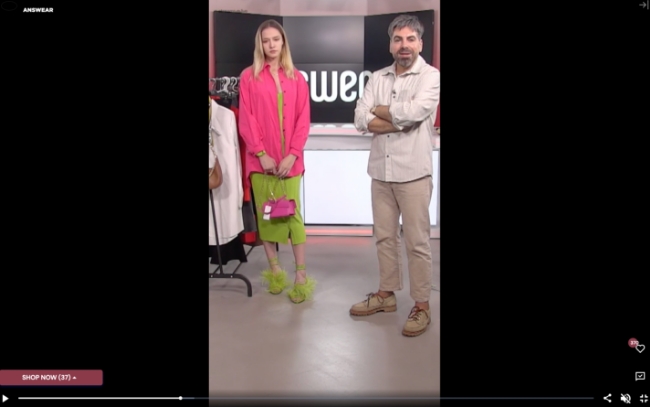
By 2025, the global eCommerce fashion industry will surpass 1 trillion US, as the average European and US consumers will spend roughly $1000 on fashion items over the course of a year. Currently estimated at over $668 billion, the online fashion industry is one of the most lucrative and competitive markets. In this article, we take a look at how live shopping works for fashion items. What makes it so efficient and why the fashion industry seems to proclaim itself the winner of this new eCommerce trend?
But first, let’s take a look at the big picture.
Online fashion is one of the most demanding and fastest-moving industries. While thousands of marketplaces, resellers, and direct-to-consumer brands fight to gain customers’ interest, technology proves to be one of the best tools to win this battle.
Innovation and fashion have always worked hand in hand, with professionals trying to innovate throughout the entire chain. We’ve seen massive innovations when it comes to used materials and production processes. Delivery and return methods have been constantly improved, as well as the marketing channels used to promote these items.
Lately, although the industry is still innovating in all sectors, the shopping journey has become the hottest point. As a consumer-centric industry, online fashion focuses on the experience of its hero: the consumer.
As consumers are spending more time online, especially on interactive platforms, their shopping habits have changed. Any experience needs to be a dynamic, interactive one. People are starting to experience new technologies and so does the fashion industry.
And it may not be long before our online shopping journeys will look like this.

Shopping in Metaverse: Gucci in Roblox. Source: Youtube
But before we all start buying in the Metaverse, another trend is shaking eCommerce. Live Shopping – “the next big thing in retail” as Fortune named this eCommerce experience.
Before diving into how it helps companies, let’s see what live shopping is all about.
What is live shopping?
Live shopping is the eCommerce experience where customers can buy goods straight from a live video experience. It mixes commerce with entertainment and live video to create the ultimate online shopping experience.
On one side we have a host that is showcasing the products live. On the other side (of the screen) we have the customers that watch this video experience, interact through the chat, ask questions, and buy the products with a few clicks of a button.
As live video is the closest thing to live interaction, live shopping takes the best from both online and in-store shopping. This new shopping experience is fundamentally changing how we buy fashion.
Live shopping is an interactive experience. Customers can use the live chat or real-time video to ask questions about products. This helps merchants answer questions that may stop customers from buying. It has a social component, allowing viewers to also interact with each other.
Live shopping is eCommerce powered by human interactions, taking the best from both online and offline shopping experiences and delivering the ultimate customer experience.
But most importantly, it’s a sales channel that can guide customers through the entire shopping journey.
Live video shopping helps customers:
- Discover new brands and products
- Research products and get feedback from other shoppers
- Interact with brand representatives and get their questions answered on the spot
- Buy products straight from the live video experience
Why live shopping goes hand in hand with fashion items
According to Mckinsey, most live shopping sessions are in the spectrum of fashion. They are followed by beauty products, another industry where customers need to properly understand how a product presents itself before actually purchasing it.

Live shopping provides the best conversion rates
Especially for fashion items, customers need to better understand how the products actually look and feel and how they fit. This is one of the reasons people still prefer to buy in-store, especially when it comes to high-ticket items.
The customer may not be able to see all the colors and sizes available. For example, customers may have a very specific color in mind for a dress or pair of shoes. In some cases, the picture may not be representative of the actual product. This can be caused by lighting, bad angles, or other reasons.
A live shopping session helps your customers get the real feeling of your product. Imagine you are selling a jacket (or any other fashion item for that matter): a live video session allows you to showcase it from different angles and offer a 360-degree overview. Customers can see how it looks when it’s worn. And at the same time, you can offer relevant tips on how to take care of the item after purchase.
Live shopping is fun, engaging, and it helps sellers use the momentum in their favor. Customers can buy products from the video experience directly, transforming live shopping into the best-converting channel for online sales.
Live shopping helps fashion brands promote multiple items at once
Let’s continue with the same example presented above. You are showcasing a jacket to your online audience. They’re loving it, and you know that this particular jacket pairs perfectly with a specific shirt.
A good eCommerce website will recommend a related item after a purchase is made. In some specific cases, maybe a follow email will present an entire outfit centered on the specific fashion item. But as this is done after the initial purchase, the momentum is lost.
With live shopping, you can combine items during the shopping journey. You can present items that work together and even showcase entire outfits.
Let’s take this example from our partners at Answear. During their Autumn Fashion Inspiration session, they were showcasing outfits from their newest collection. Instead of focusing just on individual items, they helped their customers get a better understanding of how to use them and create outstanding outfits.

Live Shopping session for Answear. Source: Streams.live
The result? 8.5% conversion rate. When you focus on helping your customers better understand how to combine your items, they will reward you. It’s a win-win situation. Guiding your customers increases the average order size, but most importantly it transforms them into your fans.
You become more than a merchant – you are the experienced consultant that helps them look outstanding. And this is what fashion is all about.
Live shopping reduces return rates
Returns are one of the biggest problems for online fashion brands and sellers. While the return rates for in-store purchases maintain between 8 and 10 percent, the situation is much worse for online sellers. While the average is constant at around 30%, some niches experience spikes close to 50% according to Shopify’s Fashion Industry Report.
And while the online fashion industry keeps growing, this problem keeps getting bigger. For sellers, shoppers, and the environment as well. For all of us.
While some reasons are out of your control, some can be addressed by live shopping. A comprehensive product presentation will deliver the expected results. This will help your customers understand the specifics of your items. The live video experience will showcase the exact style of each particular piece; thus helping them understand if it matches their style or not.
As 64% of return rates are caused by differences between the product description and the actual products or by customers not properly understanding the product specifications, live shopping will help you address this issue as well. And by combining industry reports and data from our partners, live shopping sees return rates up to 40% lower than other sales channels.
Live shopping helps fashion brands build authority
As you could see, live shopping sessions can help your customers make the best decision. You can inspire them, get them in line with the latest trends, and help them choose the best outfits.
Fashion is all about the experience. You start by helping customers imagine themselves wearing your items. During the shopping journey, your input is priceless. Your customers will have questions and uncertainties. Help them obtain the confidence they are looking for and they will reward your efforts.
There are so many stores, clothes, and accessories that shoppers are often overwhelmed. That’s why fashion stylists are always in demand. By becoming the go-to place for customers that need fashion advice, your brand’s awareness will help you increase sales. Thus helping your business become one of the industry’s leaders.
Final thoughts
As part of one of the most competitive industries, online fashion businesses need to always find the best solution to serve clients. Luckily, live shopping for fashion opens the doors to a completely new experience. Clients are helped make better decisions, while companies like yours find a way to boost sales, reduce returns and transform shoppers into fans.





